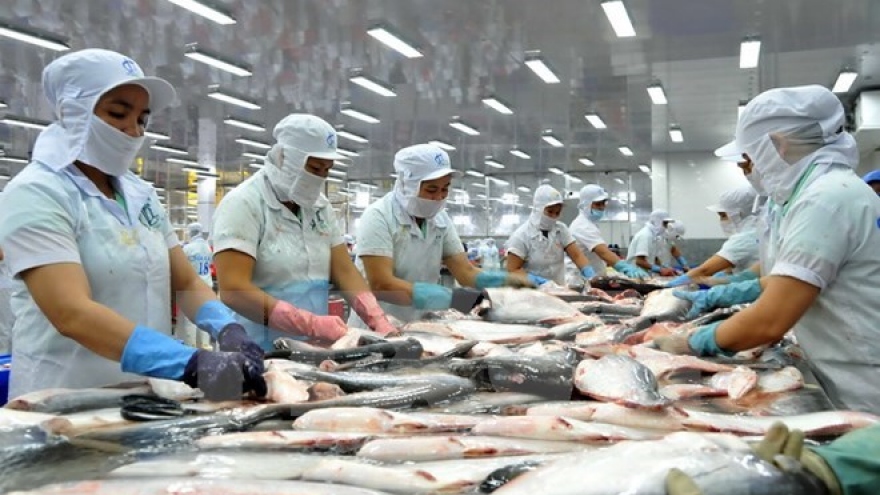Catfish exporters prepare for strict US inspections
Catfish breeders, processors and exporters in the Cuu Long (Mekong) Delta are under pressure to meet the stricter standards on food hygiene and safety under new US regulations.
Truong Đình Hoe, general secretary of the Vietnam Association of Seafood Exporters and Producers (VASEP), has told exporters to work closely with consultants and Vietnamese agencies to meet US inspections on catfish exports.
The US is the leading export market for Vietnamese catfish.
Exporters of catfish and other Siluriformes fish have been struggling with the US Department of Agriculture’s (USDA) Final Rule, which took effect in March to regulate locally raised and imported Siluriformes fish.
Under the rule, an 18-month transitional implementation period is applied to both domestic and international catfish producers.
Vo Hung Dung, deputy chairman and general secretary of the Vietnam Pangasius Association, said the rule could cause enterprises to lose the US catfish market, which accounts for more than 20% of Vietnamese catfish exports.
 |
| Timeline for US inspection programme of Vietnamese catfish exports |
The challenge for enterprises is significant as the new inspections are viewed by industry insiders in Việt Nam as a way of limiting catfish exports.
Nguyen Ngo Vi Tam, CEO of Vinh Hoan Corporation, one of the leading exporters of catfish to the US, said Vinh Hoan was one of a handful of pioneering local companies that applied an integrated production chain, ranging from breeding, farming, processing and export.
Only three Vietnamese catfish companies export to the US, with Vinh Hoan accounting for 45% of the market share, according to Tam.
The company owns more than 450 hectares of breeding ponds and can manage 60% of raw material needs for processing and exporting. It has 6,000 workers that meet labour law requirements.
“Our standards ensure food safety and traceability without causing an adverse impact on the environment,” Tâm said.
The company’s catfish export turnover totalled US$112 million in the first five months of the year, up nearly 10% over the same period last year.
Last month, the company reached a record-high turnover with export valued at US$28.5 million, a rise of 48% over the same period last year.
In 2014, Vinh Hoan received BAP (Best Aquaculture Practices) Certification from GAA (Global Aquaculture Alliance) for its entire production chain.
To better prepare for US inspections and other trade barriers, the company this year plans to enhance marketing and improve sales staff in an aim to seek new export markets.
The company has maintained high market shares from between 20% and 30% in traditional markets like the UK, the Netherlands, Belgium, Canada and Australia.
In the first five months of the year, the company achieved positive export growth in China and Japan.
“We aim to increase the supply directly to large supermarkets instead of traditional import and distribution channels in importing countries,” Tam said.
However, although many processors and exporters now have their own farms and invest in advanced technologies, it is still difficult to meet all the standards and requirements imposed by importers, according to VASEP.
Import standards
Exporters face a wide variety of requirements.
For example, for the US retail market, the common standard is ACC (Aquaculture Certification Council) while the retail market of the EU requires Global GAP and ASC (Aquaculture Stewardship Council).
In a related issue, the National Agro-Forestry-Fisheries Quality Assurance Department (NAFIQAD) has asked Siluriformes fish processors and exporters to tighten management of raw materials, especially chemical and antibiotic content.
The order follows a warning by the US agency FSIS regarding two batches of catfish from two Vietnamese exporters.
The US Senate recently decided to scrap the US Department of Agriculture’s new catfish inspection programme because critics had argued it was wasteful and unnecessary.
However, the Senate decision still needs the House of Representatives’approval and President Barack Obama’s signature to take effect.
Tam of Vinh Hoan Corporation said: “I think this is good news, and it promotes free trade in the US market. But exporters and breeders should try to continue to improve food hygiene and safety standards of aquatic products to improve export quality.”
Regarding the warning from the US on two catfish batches sent by two Vietnamese exporters, Tâm said the Government should tighten supervision of the quality of catfish exports to ensure a good reputation for Vietnamese exports.
Dr. Nguyen Viet Thang, chairman of the Vietnam Pangasius Association, said the US warning had its benefits.
“I cannot confirm whether the repeal of the catfish inspection programme will be a good thing for us,” he said.
The biggest problem now is the anti-dumping duty imposed by the US on Vietnamese catfish, according to Thắng.
Though the new regulations could pose problems for exporters, it is also beneficial in that it can force breeders and exporters to improve the quality of the exports.
Experts say that Vietnamese exporters, instead of lowering prices, should focus on producing clean fish to prevent further anti-dumping duties.
Total export value of Vietnamese tra fish to the US had a year-on-year increase of 7.2% to US$115.1 million, according to VASEP.
Vietnam’s catfish exports are estimated to reach US$1.5 billion this year, down 5% from last year.
The anti-dumping tax, the US catfish inspection programme and competition with white-flesh fish have been blamed for the decline in catfish exports, according to VASEP.
Catfish is popular in the US, with the market dominated by local producers mostly from southern states such as Mississippi, Arkansas, Louisiana and Alabama.
In recent years, US catfish producers have faced pressure from cheaper imported Asian fish.



